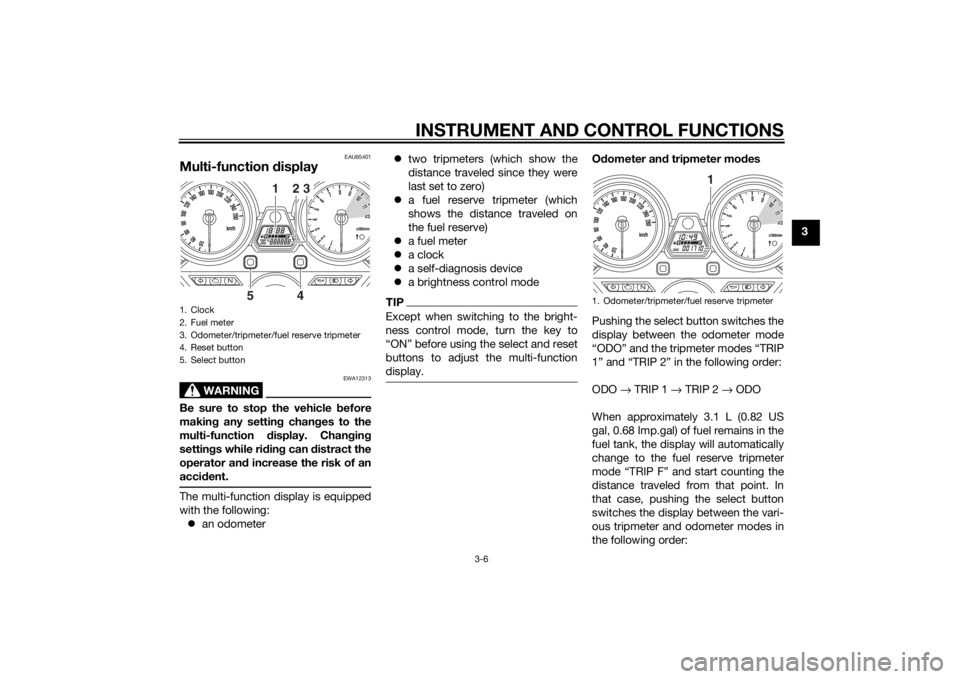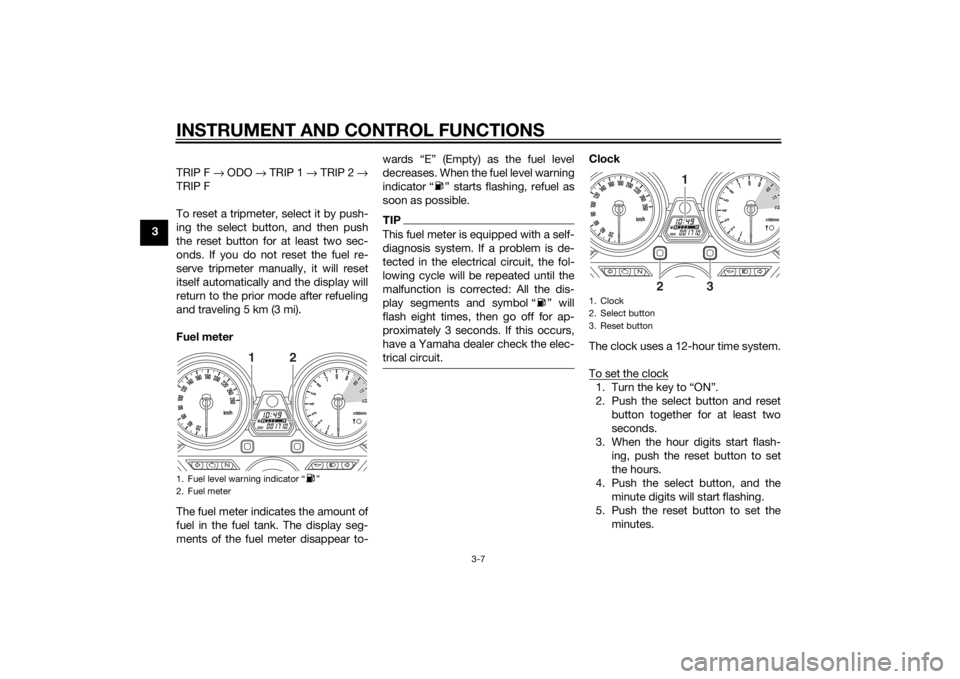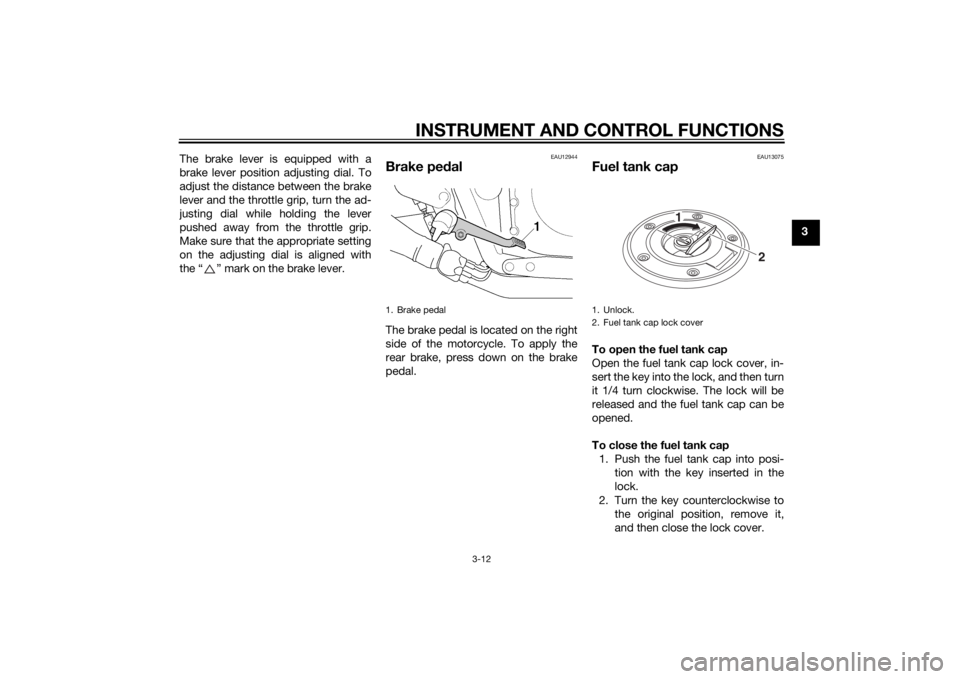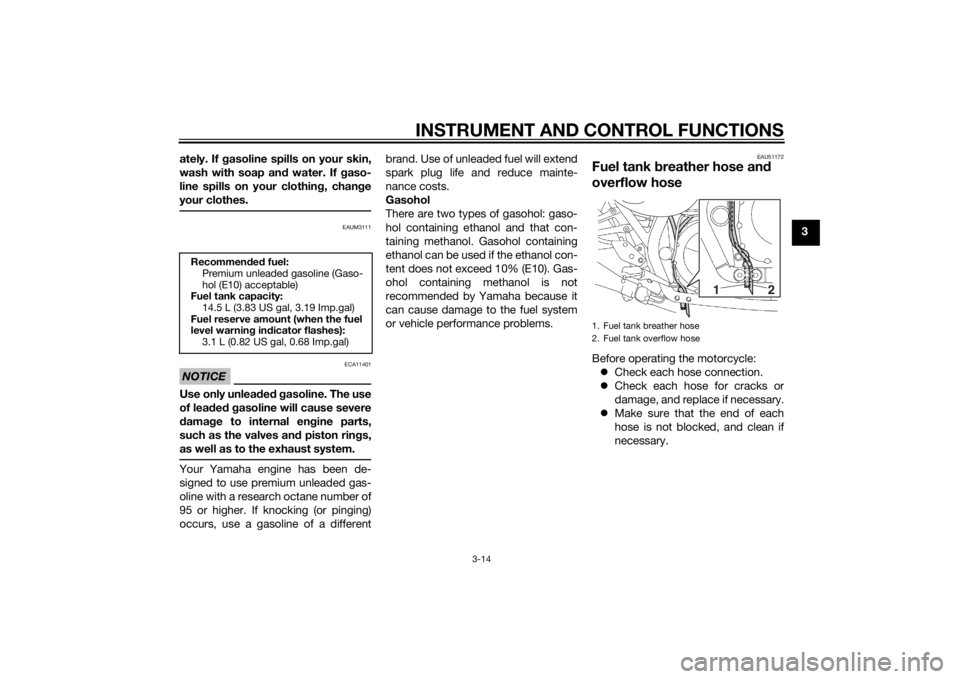fuel YAMAHA XJ 1300 2015 Owners Manual
[x] Cancel search | Manufacturer: YAMAHA, Model Year: 2015, Model line: XJ 1300, Model: YAMAHA XJ 1300 2015Pages: 98, PDF Size: 2.6 MB
Page 6 of 98

TABLE OF CONTENTSSAFETY INFORMATION.................. 1-1
DESCRIPTION .................................. 2-1
Left view ......................................... 2-1
Right view ....................................... 2-2
Controls and instruments ............... 2-3
INSTRUMENT AND CONTROL
FUNCTIONS ...................................... 3-1
Immobilizer system......................... 3-1
Main switch/steering lock............... 3-2
Indicator lights and warning lights............................................ 3-4
Speedometer .................................. 3-5
Tachometer .................................... 3-5
Multi-function display ..................... 3-6
Handlebar switches ........................ 3-9
Clutch lever .................................. 3-10
Shift pedal .................................... 3-11
Brake lever.................................... 3-11
Brake pedal .................................. 3-12
Fuel tank cap ................................ 3-12
Fuel ............................................... 3-13
Fuel tank breather hose and
overflow hose ............................ 3-14
Catalytic converters...................... 3-15
Seat .............................................. 3-15
Adjusting the front fork ................. 3-16
Adjusting the shock absorber
assembly ................................... 3-18
Luggage strap holders ................. 3-21 EXUP system ................................ 3-21
Sidestand ...................................... 3-21
Ignition circuit cut-off system ....... 3-22
FOR YOUR SAFETY –
PRE-OPERATION CHECKS ............. 4-1
OPERATION AND IMPORTANT
RIDING POINTS ................................ 5-1
Starting the engine .......................... 5-1
Shifting ............................................ 5-2
Tips for reducing fuel consumption ................................ 5-3
Engine break-in ............................... 5-3
Parking ............................................ 5-4
PERIODIC MAINTENANCE AND
ADJUSTMENT ................................... 6-1
Owner’s tool kit ............................... 6-2
Periodic maintenance chart for the emission control system .............. 6-3
General maintenance and lubrication chart ........................... 6-4
Removing and installing panels ...... 6-8
Checking the spark plugs ............... 6-9
Engine oil and oil filter element ..... 6-10
Replacing the air filter element and cleaning the check hose..... 6-13
Checking the throttle grip free
play ............................................ 6-15
Valve clearance ............................. 6-15 Tires .............................................. 6-15
Cast wheels .................................. 6-18
Clutch lever................................... 6-18
Checking the brake lever free
play ............................................ 6-18
Brake light switches ..................... 6-19
Checking the front and rear brake pads .......................................... 6-19
Checking the brake and clutch fluid levels.................................. 6-20
Changing the brake and clutch
fluids .......................................... 6-21
Drive chain slack........................... 6-22
Cleaning and lubricating the drive chain.......................................... 6-23
Checking and lubricating the cables ........................................ 6-24
Checking and lubricating the throttle grip and cable ............... 6-24
Checking and lubricating the
brake and shift pedals............... 6-24
Checking and lubricating the brake and clutch levers ............. 6-25
Checking and lubricating the sidestand................................... 6-26
Lubricating the swingarm
pivots......................................... 6-26
Checking the front fork ................. 6-26
Checking the steering................... 6-27
Checking the wheel bearings ....... 6-28
Battery .......................................... 6-28U2PNE0E0.book Page 1 Tuesday, September 16, 2014 4:15 PM
Page 12 of 98

SAFETY INFORMATION
1-5
1operator and may limit control
ability, therefore, such accesso-
ries are not recommended.
Use caution when adding electri-
cal accessories. If electrical ac-
cessories exceed the capacity of
the motorcycle’s electrical sys-
tem, an electric failure could re-
sult, which could cause a
dangerous loss of lights or engine
power.
Aftermarket Tires an d Rims
The tires and rims that came with your
motorcycle were designed to match
the performance capabilities and to
provide the best combination of han-
dling, braking, and comfort. Other
tires, rims, sizes, and combinations
may not be appropriate. Refer to page
6-15 for tire specifications and more in-
formation on replacing your tires.
Transportin g the Motorcycle
Be sure to observe following instruc-
tions before transporting the motorcy-
cle in another vehicle. Remove all loose items from the
motorcycle.
Check that the fuel cock (if
equipped) is in the “OFF” position
and that there are no fuel leaks.
Point the front wheel straight
ahead on the trailer or in the truck
bed, and choke it in a rail to pre-
vent movement.
Shift the transmission in gear (for
models with a manual transmis-
sion).
Secure the motorcycle with tie-
downs or suitable straps that are
attached to solid parts of the mo-
torcycle, such as the frame or up-
per front fork triple clamp (and not,
for example, to rubber-mounted
handlebars or turn signals, or
parts that could break). Choose
the location for the straps carefully
so the straps will not rub against
painted surfaces during transport.
The suspension should be com-
pressed somewhat by the tie-
downs, if possible, so that the mo-
torcycle will not bounce exces-
sively during transport.
U2PNE0E0.book Page 5 Tuesday, September 16, 2014 4:15 PM
Page 14 of 98

DESCRIPTION
2-2
2
EAU10421
Right view
2
6
3
1
4
5
7
8
9
10
11
1. Owner’s tool kit (page 6-2)
2. Rear brake fluid reservoir (page 6-20)
3. Battery (page 6-28)
4. Air filter element (page 6-13)
5. Fuel tank cap (page 3-12)
6. Headlight (page 6-30)
7. Engine oil filler cap (page 6-10)
8. Engine oil drain bolt (page 6-10) 9. Engine oil level check window (page 6-10)
10.Brake pedal (page 3-12)
11.Rear brake light switch (page 6-19)U2PNE0E0.book Page 2 Tuesday, September 16, 2014 4:15 PM
Page 21 of 98

INSTRUMENT AND CONTROL FUNCTIONS
3-6
3
EAU65401
Multi-function display
WARNING
EWA12313
Be sure to stop the vehicle before
makin g any settin g chan ges to the
multi-function display. Chan gin g
settin gs while ri din g can distract the
operator an d increase the risk of an
acci dent.The multi-function display is equipped
with the following:
an odometer
two tripmeters (which show the
distance traveled since they were
last set to zero)
a fuel reserve tripmeter (which
shows the distance traveled on
the fuel reserve)
a fuel meter
a clock
a self-diagnosis device
a brightness control mode
TIPExcept when switching to the bright-
ness control mode, turn the key to
“ON” before using the select and reset
buttons to adjust the multi-function
display.
Odometer an d tripmeter mo des
Pushing the select button switches the
display between the odometer mode
“ODO” and the tripmeter modes “TRIP
1” and “TRIP 2” in the following order:
ODO → TRIP 1 → TRIP 2 → ODO
When approximately 3.1 L (0.82 US
gal, 0.68 Imp.gal) of fuel remains in the
fuel tank, the display will automatically
change to the fuel reserve tripmeter
mode “TRIP F” and start counting the
distance traveled from that point. In
that case, pushing the select button
switches the display between the vari-
ous tripmeter and odometer modes in
the following order:
1. Clock
2. Fuel meter
3. Odometer/tripmeter/fuel reserve tripmeter
4. Reset button
5. Select button
1
23
5
4
1. Odometer/tripmeter/fuel reserve tripmeter
1
U2PNE0E0.book Page 6 Tuesday, September 16, 2014 4:15 PM
Page 22 of 98

INSTRUMENT AND CONTROL FUNCTIONS
3-7
3TRIP F
→ ODO → TRIP 1 → TRIP 2 →
TRIP F
To reset a tripmeter, select it by push-
ing the select button, and then push
the reset button for at least two sec-
onds. If you do not reset the fuel re-
serve tripmeter manually, it will reset
itself automatically and the display will
return to the prior mode after refueling
and traveling 5 km (3 mi).
Fuel meter
The fuel meter indicates the amount of
fuel in the fuel tank. The display seg-
ments of the fuel meter disappear to- wards “E” (Empty) as the fuel level
decreases. When the fuel level warning
indicator “ ” starts flashing, refuel as
soon as possible.
TIPThis fuel meter is equipped with a self-
diagnosis system. If a problem is de-
tected in the electrical circuit, the fol-
lowing cycle will be repeated until the
malfunction is corrected: All the dis-
play segments and symbol “ ” will
flash eight times, then go off for ap-
proximately 3 seconds. If this occurs,
have a Yamaha dealer check the elec-
trical circuit.
Clock
The clock uses a 12-hour time system.
To set the clock1. Turn the key to “ON”.
2. Push the select button and reset
button together for at least two
seconds.
3. When the hour digits start flash- ing, push the reset button to set
the hours.
4. Push the select button, and the minute digits will start flashing.
5. Push the reset button to set the minutes.
1. Fuel level warning indicator “ ”
2. Fuel meter
2
1
1. Clock
2. Select button
3. Reset button
1
2
3
U2PNE0E0.book Page 7 Tuesday, September 16, 2014 4:15 PM
Page 27 of 98

INSTRUMENT AND CONTROL FUNCTIONS
3-12
3
The brake lever is equipped with a
brake lever position adjusting dial. To
adjust the distance between the brake
lever and the throttle grip, turn the ad-
justing dial while holding the lever
pushed away from the throttle grip.
Make sure that the appropriate setting
on the adjusting dial is aligned with
the “ ” mark on the brake lever.
EAU12944
Brake ped
alThe brake pedal is located on the right
side of the motorcycle. To apply the
rear brake, press down on the brake
pedal.
EAU13075
Fuel tank capTo open the fuel tank cap
Open the fuel tank cap lock cover, in-
sert the key into the lock, and then turn
it 1/4 turn clockwise. The lock will be
released and the fuel tank cap can be
opened.
To close the fuel tank cap
1. Push the fuel tank cap into posi- tion with the key inserted in the
lock.
2. Turn the key counterclockwise to the original position, remove it,
and then close the lock cover.
1. Brake pedal
1. Unlock.
2. Fuel tank cap lock cover
2
1
U2PNE0E0.book Page 12 Tuesda
y, September 16, 2014 4:15 PM
Page 28 of 98

INSTRUMENT AND CONTROL FUNCTIONS
3-13
3
TIPThe fuel tank cap cannot be closed un-
less the key is in the lock. In addition,
the key cannot be removed if the cap is
not properly closed and locked.
WARNING
EWA11092
Make sure that the fuel tank cap is
properly closed after fillin g fuel.
Leakin g fuel is a fire hazar d.
EAU13213
FuelMake sure there is sufficient gasoline in
the tank.
WARNING
EWA10882
Gasoline an d g asoline vapors are
extremely flammab le. To avoid fires
an d explosions an d to re duce the
risk of injury when refuelin g, follow
these instructions.1. Before refueling, turn off the en- gine and be sure that no one is sit-
ting on the vehicle. Never refuel
while smoking, or while in the vi-
cinity of sparks, open flames, or
other sources of ignition such as
the pilot lights of water heaters
and clothes dryers.
2. Do not overfill the fuel tank. Stop filling when the fuel reaches the
bottom of the filler tube. Because
fuel expands when it heats up,
heat from the engine or the sun
can cause fuel to spill out of the
fuel tank. 3. Wipe up any spilled fuel immedi-
ately. NOTICE: Immediately
wipe off spille d fuel with a clean,
d ry, soft cloth, since fuel may
d eteriorate painted surfaces or
plastic parts.
[ECA10072]
4. Be sure to securely close the fuel tank cap.
WARNING
EWA15152
Gasoline is poisonous an d can
cause injury or death. Han dle gaso-
line with care. Never siphon gasoline
b y mouth. If you should swallow
some gasoline or inhale a lot of g as-
oline vapor, or g et some gasoline in
your eyes, see your doctor imme di-1. Fuel tank filler tube
2. Maximum fuel level
12
U2PNE0E0.book Page 13 Tuesda y, September 16, 2014 4:15 PM
Page 29 of 98

INSTRUMENT AND CONTROL FUNCTIONS
3-14
3
ately. If g
asoline spills on your skin,
wash with soap an d water. If gaso-
line spills on your clothin g, chan ge
your clothes.
EAUM3111
NOTICE
ECA11401
Use only unlea ded g asoline. The use
of lead ed g asoline will cause severe
d amag e to internal en gine parts,
such as the valves an d piston rin gs,
as well as to the exhaust system.Your Yamaha engine has been de-
signed to use premium unleaded gas-
oline with a research octane number of
95 or higher. If knocking (or pinging)
occurs, use a gasoline of a different brand. Use of unleaded fuel will extend
spark plug life and reduce mainte-
nance costs.
Gasohol
There are two types of gasohol: gaso-
hol containing ethanol and that con-
taining methanol. Gasohol containing
ethanol can be used if the ethanol con-
tent does not exceed 10% (E10). Gas-
ohol containing methanol is not
recommended by Yamaha because it
can cause damage to the fuel system
or vehicle performance problems.
EAU51172
Fuel tank
breather hose an d
overflow hoseBefore operating the motorcycle:
Check each hose connection.
Check each hose for cracks or
damage, and replace if necessary.
Make sure that the end of each
hose is not blocked, and clean if
necessary.
Recommen ded fuel:
Premium unleaded gasoline (Gaso-
hol (E10) acceptable)
Fuel tank capacity:
14.5 L (3.83 US gal, 3.19 Imp.gal)
Fuel reserve amount (when the fuel
level warnin g in dicator flashes):
3.1 L (0.82 US gal, 0.68 Imp.gal)
1. Fuel tank breather hose
2. Fuel tank overflow hose
2
1
U2PNE0E0.book Page 14 Tuesda y, September 16, 2014 4:15 PM
Page 39 of 98

FOR YOUR SAFETY – PRE-OPERATION CHECKS
4-1
4
EAU15598
Inspect your vehicle each time you use it to make sure the vehicle is in safe operating condition. Always follow the inspection
and maintenance procedures and schedules described in the Owner’s Manual.
WARNING
EWA11152
Failure to inspect or maintain the vehicle properly increases the possibility of an accident or equipment d amage.
Do not operate the vehicle if you fin d any pro blem. If a pro blem cannot b e corrected b y the proce dures provi ded in
this manual, have the vehicle inspecte d b y a Yamaha dealer.Before using this vehicle, check the following points:
ITEM CHECKS PAGE
Fuel • Check fuel level in fuel tank.
• Refuel if necessary.
• Check fuel line for leakage.
• Check fuel tank breather hose and overflow hose for obstructions, cracks or
damage, and check hose connections. 3-13, 3-14
En gine oil • Check oil level in engine.
• If necessary, add recommended oil to specified level.
• Check vehicle for oil leakage. 6-10
Front brake • Check operation.
• If soft or spongy, have Yamaha dealer bleed hydraulic system.
• Check brake pads for wear.
• Replace if necessary.
• Check fluid level in reservoir.
• If necessary, add specified brake fluid to specified level.
• Check hydraulic system for leakage. 6-19, 6-20
U2PNE0E0.book Page 1 Tuesday, September 16, 2014 4:15 PM
Page 44 of 98

OPERATION AND IMPORTANT RIDING POINTS
5-3
5
EAU16811
Tips for reducin g fuel con-
sumptionFuel consumption depends largely on
your riding style. Consider the follow-
ing tips to reduce fuel consumption:
Shift up swiftly, and avoid high en-
gine speeds during acceleration.
Do not rev the engine while shift-
ing down, and avoid high engine
speeds with no load on the en-
gine.
Turn the engine off instead of let-
ting it idle for an extended length
of time (e.g., in traffic jams, at traf-
fic lights or at railroad crossings).
EAU16842
Engine break-inThere is never a more important period
in the life of your engine than the period
between 0 and 1600 km (1000 mi). For
this reason, you should read the fol-
lowing material carefully.
Since the engine is brand new, do not
put an excessive load on it for the first
1600 km (1000 mi). The various parts in
the engine wear and polish themselves
to the correct operating clearances.
During this period, prolonged full-throt-
tle operation or any condition that
might result in engine overheating
must be avoided.
EAU17094
0–1000 km (0–600 mi)
Avoid prolonged operation above 4800
r/min. NOTICE: After 1000 km (600
mi) of operation, the en gine oil must
b e chan ged an d the oil filter car-
tri dg e or element replace d.
[ECA10303]
1000–1600 km (600–1000 mi)
Avoid prolonged operation above 5700
r/min. 1600 km (1000 mi) an
d b eyon d
The vehicle can now be operated nor-
mally.
NOTICE
ECA10311
Keep the en gine spee d out of
the tachometer red zone.
If any en gine trou ble shoul d oc-
cur during the en gine break-in
period , imme diately have a
Yamaha dealer check the vehi-
cle.
U2PNE0E0.book Page 3 Tuesday, September 16, 2014 4:15 PM